Nine races have developed the ability to journey to the stars—now it’s a race to see who will become Master of the Galaxy.
At a glance:
Master of the Galaxy is a 4X game for 2 to 4 players, ages 10 and up, and takes about 30 minutes per player. It’s currently seeking funding on Kickstarter, with a pledge of $40 (plus shipping) for a copy of the game. The game combines bag-building and card-drafting as you explore, expand, exploit, and exterminate your way to victory. I’ve played this with both my own kids (ages 13 and 10) and adults, and feel the age rating is appropriate—it is not as complex to learn as some 4X games I’ve played.
New to Kickstarter? Read our crowdfunding primer, and check out our curated page of projects we love.
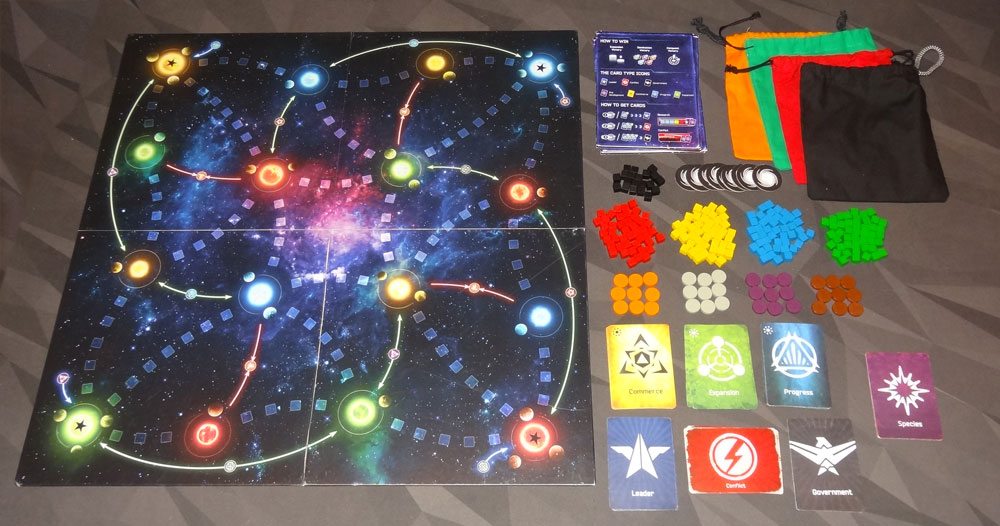
Master of the Galaxy Components
The game includes:
- 36 Politics cards
- 18 Leader cards
- 9 Conflict cards
- 9 Government cards
- 27 Development cards
- 9 Commerce cards
- 9 Expansion cards
- 9 Progress cards
- 9 Species cards
- 9 Black Hole tokens
- 200 Resource cubes (45 each red, blue, yellow, green; 20 black)
- 36 Bases (9 each gray, brown, orange, purple)
- game board
- 4 cloth bags
- 4 player aids
Note: my review is based on a pre-production prototype, so the exact component list and the quality may differ in the finished version. The artwork and graphic design looks complete so I imagine the game will look fairly similar to what you see in my photos. The cloth bags in my version do not match the player colors, but I imagine they will either be all black or in player colors in the final version.

(Prototype shown) Photo: Jonathan H. Liu
The game looks very nice overall: the illustrations for the species and developments are nice; for the most part I found the cards easy to understand, with iconography that is fairly intuitive. There are spaces on cards to place resource cubes, and then when it’s filled up, you get some sort of effect. I don’t know if using red and green as cubes and resource spaces on the cards (with no additional differentiation) will make this game impossible for color-blind players.
However, there were a few things that were confusing. For instance, the development cards come in yellow (commerce), green (expansion), and blue (progress), but the icon for a development card of your choice is purple. Also, on many of the cards and on the game board there are supremacy symbols—usually their presence on a card means that you’ve earned symbol. But on the leader cards, the symbols are a prerequisite for gaining that leader’s ability, which can be confusing. Finally, the conflict cards were particularly tricky to explain who gets what when resolving the card, because of the way the arrows go back and forth.
The components themselves are fairly standard: wooden cubes for resources, wooden discs for bases, cards, and a board. That means the game shouldn’t require too much special preparation for manufacturing. That, combined with Ares Games’ established experience in publishing games, means that I would trust in their ability to deliver the game in a timely manner.
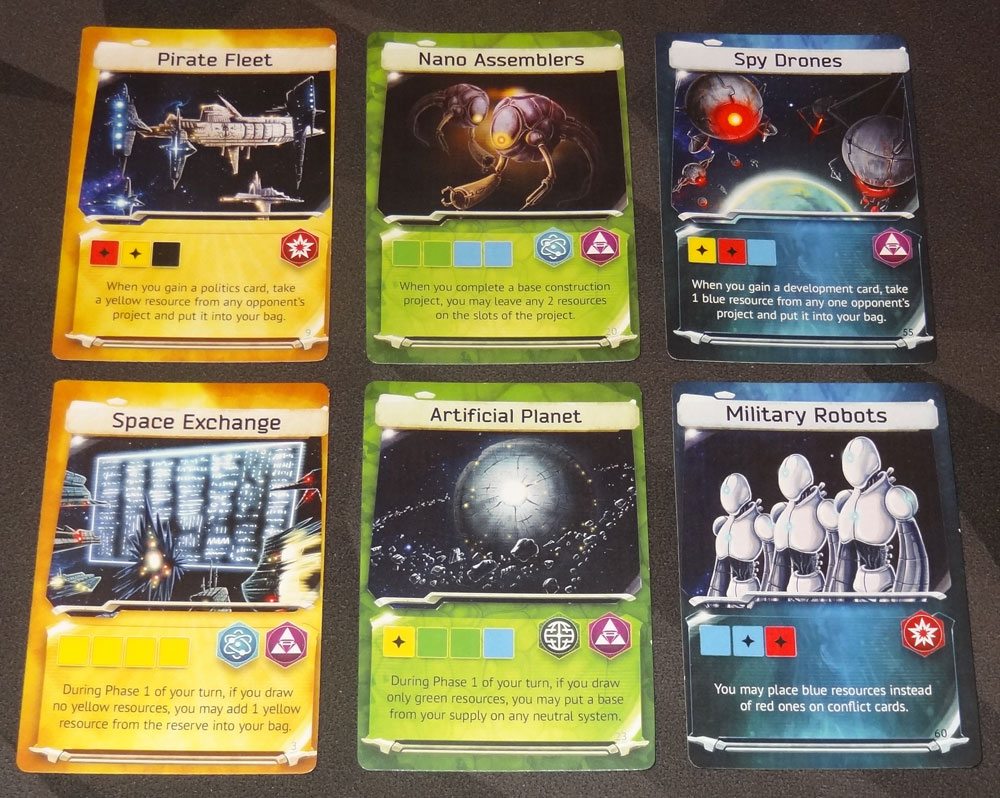
(Prototype shown) Photo: Jonathan H. Liu
How to Play Master of the Galaxy
You can download the rules to Master of the Galaxy on BGG.
Goal
The object of Master of the Galaxy is to be first to achieve galactic supremacy through one of three ways:
- Expansion: place all 9 of your bases on the game board.
- Domination: collect 5 supremacy symbols of the same type on your cards and star systems.
- Conquest: capture a second starting system and establish a base on it.

Setup
Place the board in the center of the table, with the various decks of cards nearby.
Each player takes a bag and places 5 cubes of each color into it. The rest of the cubes are placed next to the board as the reserve. (Black cubes are returned to the box and do not go into the reserve.) Each player also takes the 9 bases of their player color. The start player pulls a cube from their bag at random (re-drawing if they get black) to see which starting star system will be theirs. Turn the board so that the matching star system is in front of that player. Other players will use the star systems closest to them. (Note that if you have fewer than four players, there will be some unused systems that are covered with black hole tokens. In a two-player game, the two players should be at opposite corners.) Each player places a base on their starting system.
Then, each player will draw a species card. In Master of the Galaxy, whenever you “draw” a card, you get to take the top two from the face-up deck. You may keep either the first or second, placing the other at the bottom of the deck, or put them both at the bottom of the deck and take the next card from the top of the deck. All cards are placed in front of you on the table.
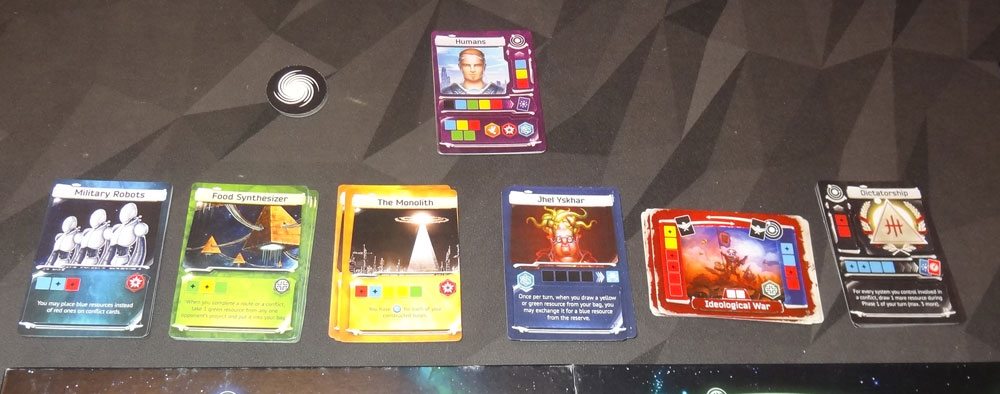
After everyone has chosen a species, shuffle all the other decks and turn them face-up.
Taking Your Turn
On your turn, you do three things:
- Gain resources: draw three cubes from your bag.
- Allocate resources: place the cubes on your cards and on the board.
- Use and Discard cards: initiate conflicts, use discard abilities, and gain resources.
Step 1 is pretty self-explanatory.
Allocate Resources
During Step 2, you may place cubes in various places: on a card, on a trade route, or on a planet in your systems.
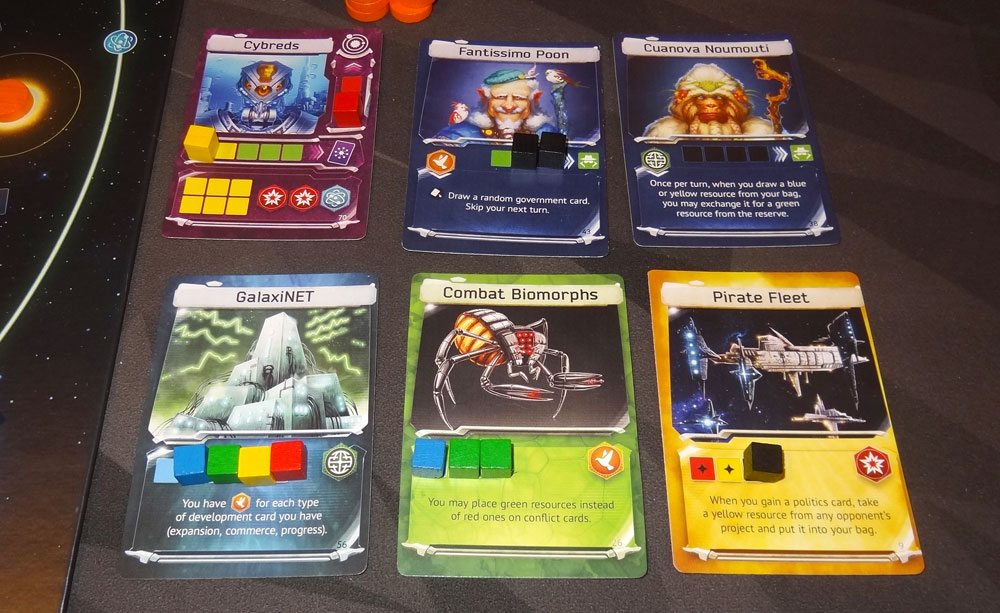
Cubes may be placed on matching colors on a card—each project may be filled in any order. When you fill a section, then you gain the effect shown. You can construct bases (which remain on the card until placed), gain cards, gain supremacy symbols, and implement development cards. Development cards do not have any abilities (or give you the supremacy symbols shown) until the colored spaces are filled. Leader cards also sometimes have abilities that let you steal cubes from other players.
In most cases, when you fill up a card and gain its ability, you will put the cubes from it back into your bag. If any of the spaces are marked with black diamonds, then those cubes are “irretrievable losses” and are placed back into the reserve instead. When you fill the spaces on a development card or the supremacy symbols project at the bottom of your species card, those cubes stay on the card.
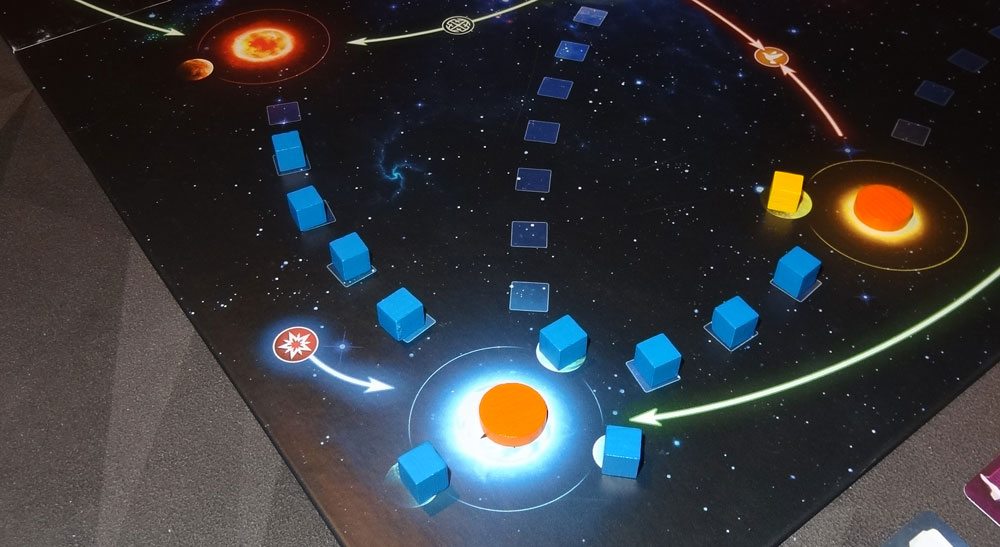
You may also place cubes on trade routes—these are the square spaces leading between star systems. You must start from one of your own star systems, and may only build trade routes to neutral (unoccupied) systems. The color you use must match either the origin or destination star, and once you’ve started a trade route, all cubes must be of a single color.
Finally, you may place cubes on planets in your own systems to settle them and harvest resources. Settling a planet lets you gain cubes of the color you used—3 cubes if the cube matches the planet’s color, and 2 cubes otherwise. Take cubes from the reserve and put them into your bag.
A black cube may be used to cancel any single project (including a trade route): put the black cube back into your bag, and then pick up the cubes from the project and return them to your bag (except for irretrievable losses).

Building Bases
Building bases also happens during Step 2. When you fill a base-constructing project (e.g., at the top of your Species card), you put a base on the card and return the cubes to your bag. That is now a constructed base, which may be added to a star system when you have established a trade route, or taken it over in a conflict. You may build as many bases on a star system as there are planets there, so your starting system may have up to 3 bases, and other planets may have 1 or 2. In order to build a second or third base, that star system must be connected to another system with a trade route.
When you build bases, you will get to draw politics cards as a bonus. The first base gets you a leader card, the second gets you a conflict card, and the third gets you a government card.
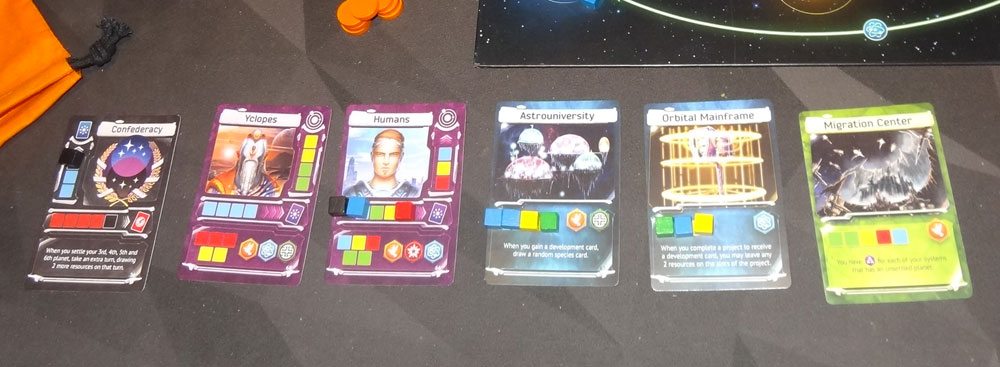
Development Cards
When you complete a project on a development card, you gain the abilities of that card, as well as the supremacy symbols listed on it. You also get to draw a politics card as a bonus, similar to building bases. The first card of one type gets you a leader card, the second card of the same type gets you a conflict card, and the third (or more) card of that type gets you a government card.

Use and Discard Cards
During Step 3, you may initiate conflicts if you have conflict cards. You place the conflict card between your star system and one that is not yours, covering the trade route spaces. Conflict cards may be filled on either side with resources, though if you start a conflict with a neutral system it will not fight back. If you currently have more resources on your side of a conflict card, you also have the supremacy symbol shown on it.

Whenever a player fills up their side of the conflict card, they get some benefits:
- Take the number of resources shown at the bottom of the card from the losing player (or the reserve, if it was against a neutral system).
- Take the cards shown next to the other player’s system from that player, if any. (None for neutral systems.)
- Discard cards shown with a starburst next to the other player’s system, if any.
- Gain access to the star system, if shown on that side of the card. You may remove any bases present and place one of your own constructed bases there.
- Take the conflict card for future use—neither player has that supremacy symbol.

At the end of your turn, you may discard any number of your cards, returning their cubes to your bag (except for irretrievable losses). Your tableau has a limit of 7 cards, including your species card. Discarding cards also lets you take resources from the reserve and put them into your bag: 1 card = 1 resource; 2 cards = 3 resources; 3 or more cards = 5 resources.
In addition, some cards have a discard icon on them: these cards only trigger their abilities when discarded, and they still count toward gaining resources as well.
How the Game Ends
As soon as somebody has fulfilled one of the win conditions, they immediately become Master of the Galaxy and win the game.
For supremacy symbols, you must have 5 of the same symbol. Your starting system provides you with one symbol, and completed development cards and agenda projects on your species cards also provide symbols. On the board, there are some symbols you gain if you control both systems on either side of the green arrows; the orange dove (diplomacy) is gained if you control only one of the two systems next to it.

Some allow you to steal resources from other players, and some have discard abilities. (Prototype shown) Photo: Jonathan H. Liu
The Verdict
Master of the Galaxy uses a “bag-building” mechanic, where each person has their own bag of resource cubes. You pull cubes out of the bag and use them, and then as you play you’ll put more cubes into your bag, changing the mix and thus the probability of drawing a particular color. It also uses a form of card drafting: every time you draw a card, you actually get a choice of three cards, and your choice will affect the next player to draw from the same deck. In addition, because you are limited to seven cards in your tableau, you’ll have opportunities to change your tactics throughout the game, discarding cards to gain resource cubes.
What is 4X?
In case you’re unfamiliar with the term, 4X games are a genre of empire-building games, named after the four primary elements of the game: Explore, Expand, Exploit, and Exterminate. Although each game takes its own approach to how these elements are handled, generally a 4X game involves building up your empire both geographically and technologically, and fighting your opponents. They can have a range of settings: sci-fi, like Master of the Galaxy; fantasy, like Tiny Epic Kingdoms; or even natural, like Dominant Species.
My guess is that you probably already like some of the four elements in a 4X game as they appear in other games. Many games include “exploration,” whether through tile-laying or moving around on a map, and resource-management games are often about “expansion.” Deck-building games are a form of “exploit” when you try to build a better deck that is more powerful or more efficient, and worker-placement games have their own form of “exploiting.” And of course there are a lot of games that involve combat of some sort, the “exterminate” element.
If you enjoy 4X games, you probably like not just those individual elements, but the way that they’re combined. There are usually multiple paths to victory—in some games you will have to split your attention among the elements, and in others you may be able to specialize to focus on just one of those elements. In Master of the Galaxy, you can win in three different ways, but you will probably need to do at least a little of each. The one odd thing to me is that in this case the entire board is already “known” from the beginning of the game, so I feel that there isn’t “exploration” in the usual sense, where you are either laying tiles or uncovering new locations—that also may explain why there isn’t a win condition that is tied to exploration. Maybe call it a 3X game?
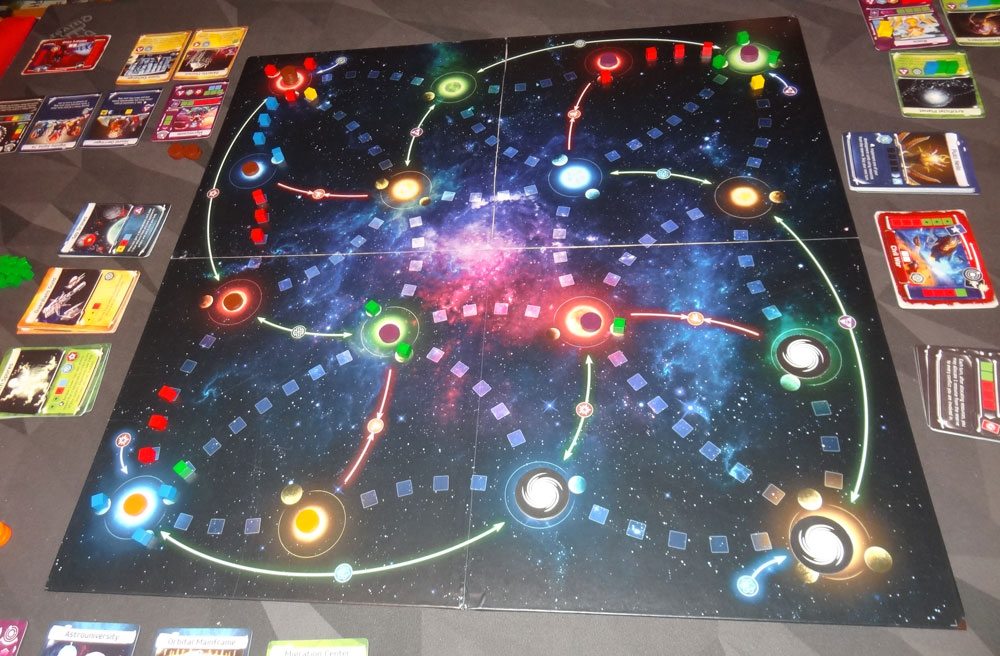
(Prototype shown) Photo: Jonathan H. Liu
Is Master of the Galaxy difficult to learn?
Overall, I found most of the rules fairly straightforward: you draw cubes from your bag, put them on cards, and then you get benefits from those cards. Or you build trade routes to expand your empire to other star systems. There are, however, rules that are easy to forget, even with the player reference cards. For instance, we often forgot to draw politics cards when placing our bases, and I totally forgot about getting politics cards when development cards were completed.
Using conflict cards is probably one of the trickier aspects of the game and I would recommend reading that part of the rulebook carefully, looking at the diagram so you know which rewards you get from which side of the card. That may explain why the games I’ve played have not tended to focus on armed conflicts as much as building trade routes and building up technology. We’ve been more focused on expansion and exploitation, mostly.
Both my 10-year-old and my 13-year-old have learned to play Master of the Galaxy, and each one has beat me once, too. While I think there is definitely some challenge in deciding on an overall strategy while playing, the rules themselves are not too hard. Compared to some other 4X games I’ve played, this one is pretty easy to start up and get a game going.

Is Master of the Galaxy fun?
I’ve really been enjoying it so far—I’ve been trying out different approaches each time I play, and it’s been fun to explore the different combinations of species, developments, and politics cards to see what works. So far I’ve seen victories through building 9 bases and through acquiring 5 supremacy symbols, and a couple times players came close to conquering a starting star system.
I like the bag-building aspect. Each player has an advantage in getting one particular color of resource at the beginning of the game, and you have to decide whether to reinforce that advantage or diversify. Three of the colors tend to drive you toward the three different types of development cards, and red tends to give you a benefit in conflicts. Deciding what to use when you settle planets (to get more cubes) and when to discard cards for more cubes is a key part of keeping your economy going. Even though you only draw 3 cubes each time, you often have several different options for how to use each cube, and figuring out the best use of them is a fun puzzle.
The card combinations is where it’s really engaging. As with any game with card powers, it’s really fun to find cards that have a good synergy. One of my daughters managed to get an Artificial Planet development: if she drew only green cubes from her bag, she could place a base from her supply onto a neutral star system—it let her bypass building trading routes and even constructing bases, as long as she could keep her bag filled with mostly green cubes. Another player had the Astrouniversity, which let him draw more species whenever he got a development card—and once he had filled his tableau, he was able to use additional development cards and species to get more resource cubes for his bag.
Combat in this game can feel a little abstract because there aren’t any fancy mechs or spaceships flying around—you just have a card that represents the battle between two systems. Ultimately it’s an issue of resources: whoever pours resources into the fight is the one who wins, and if you’re engaged in a conflict, you have to decide whether it’s worth investing in the battle, knowing that many of those resources will be lost and can’t be used for your other goals. It does make battles a little less luck-based (though you do have to draw the right cubes).
Should I back Master of the Galaxy on Kickstarter?
I think if you enjoy sci-fi 4X games, Master of the Galaxy is definitely worth checking out. Take a look at the campaign and see if it looks like your style. It doesn’t feel a lot like other 4X games I’ve played, which is one of the things I like about it—it’s a good mix of existing mechanics in a new combination. If you enjoy building up an engine through card powers, there’s a lot of opportunities for that here.
For more information or to make a pledge, visit the Master of the Galaxy Kickstarter page.
Click here for a full index of our tabletop game reviews.
Disclosure: I received a pre-production prototype for review.





